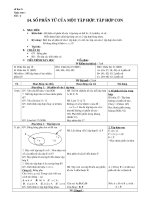chapter 4 lai phân tử
Bạn đang xem bản rút gọn của tài liệu. Xem và tải ngay bản đầy đủ của tài liệu tại đây (4.05 MB, 71 trang )
LAI PHÂN TỬ
(MOLECULAR HYBRIDIZATION)
CH NG 4ƯƠ
Concept of hybrid molecules
•
When double strand DNA is steamed to a temperature exceed
the melting temperature (Tm), it will separate into 2 single
strands DNA due to breaks of H bonds. If the reaction
temperature is then decreased slowly plus other appropriate
experimental conditions, these ssDNA will pair again. This
phenomenon is called the hybridization of molecules.
•
Characteristic of the hybrid molecules: Specificity, the re-
pairing occurs only between two complementary sequences.
•
These complementary sequences can be DNA or RNA, leading
to the formations of DNA-DNA, RNA-RNA or hybrid DNA-
RNA
TYPES OF HYBRIDIZATION
- Hybrid in liquid phase (Lai trong pha loỷng)
- Hybrid on solid phase (Lai treõn pha raộn)
- in situ hybridization (Lai taùi choó)
- Southern Blot
- Northern Blot
- Western Blot
•
First described by E. M. Southern in 1975.
•
Applications of Southern hybridization
–
RFLP’s, VNTR’s (Variable Number Tandem Repeat)
and DNA fingerprinting
–
Checking of the gene knockout mice
Southern Blot (1975)
Northern Blot (1977)
Technique for detecting specific RNAs separated
by electrophoresis by hybridization to a labeled
DNA probe.
-
Transfer RNA onto membrane
-
Hybridize with probe
-
Detection
Western blot -Immunoblot (1979)
Technique for detecting specific proteins separated by electrophoresis
by use of labeled antibodies.
Transfer proteins in SDS-PAGE onto Nylon membrane
Critical parameters
•
Concentration of target DNA, RNA, protein
•
Homology between the probe and the sequences being detected
(specificity)
–
Tm = 69,3 + 0,41 (% G + C)
–
Factors can be changed:
•
Hybridization temp.
•
Washing temp.
•
Salt concentration during washing
High temp., low salt: high stringency
Low temp., high salt: low stringency
–
If 50 % formamide is used
•
42
o
C for 95 ~ 100 % homology
•
37
o
C for 90 ~ 95 % homology
•
32
o
C for 85 ~ 90 % homology
Southern hybridization
Transfer buffer
Flow chart of Southern hybridization
Preparing the samples and running the gel
Southern transfer
Probe preparation
Prehybridization
Hybridization
Post-hybridization washing
Signal detection
Preparing the samples and running the gel
•
Digest 10 pg to 10 µg of desired DNA samples to completion.
•
Prepare an agarose gel, load samples (remember marker), and
electrophorese.
•
Stain gel with ethidium bromide solution (0.5 µg/ml).
•
Photograph gel (with ruler).
•
Transfer methods:
•
Capillary: overnight
•
Electric: 2-3 h
•
Vacuum: 30 min
•
Note:
•
Sequences > 5 kb: Low transfering efficiency hydrolyse DNA
partly by:
•
- weak acid to break purins partly
•
- strong base to break phosphodiester bonds
After Southern transfer
•
Dissemble transfer
pyramid and rinse
nitrocellulose in 2x SSC
•
Bake nitrocellulose at
80°C for 2 hr or UV-
crosslink Nylon
membrane for seconds
Preparation of isotope probes
•
Synthesis of uniformly labeled double-stranded DNA probes
•
Preparation of single-stranded probes
•
Labeling the 5′ and 3′ termini of DNA
Đánh dấu bằng các đồng vò phóng xạ -
Radioactively Labeled (dATP)
Ñaùnh daáu baèng phöông phaùp hoaù hoïc -
Non-Radioactively Labeled Precursors
Synthesis of double-stranded DNA probes
-
Nick translation of DNA
-
Labeled DNA probes using random oligonucleotide primers
Preparation of single-stranded probes
•
Synthesis of single-stranded DNA probes using
bacterio-phage M13 vectors.
•
Synthesis of RNA probes by in vitro transcription by
bacteriophage DNA-dependent RNA polymerase.
In vitro
transcription
gene A
T7 promoter
PCR
in vitro transcription using
T7 RNA polymerase
labeled RNA
•
Labeling the 3′ termini of double-stranded DNA
using the Klenow fragment of E.coli DNA
polymerase I. (lack of 5’ 3’ exonuclease activity)
•
Labeling the 3′ termini of double-stranded DNA
using bacteriophage T4 DNA polymerase.
•
Labeling the 5′ termini of DNA with bacteriophage
T4 polynucleotide kinase.
Labeling the 5′ and 3′ termini of DNA
“Fill-In“ Reaction
5‘ AATTCNNNCCC 3‘ ⇒ 5‘ AATTCNNNCCC 3‘
3‘ GNNNGGG 5‘ 3‘ AAGNNNCCC 5‘
5‘ AATTCNNNG 3‘ ⇒ 5‘ AATTCNNNGAA 3‘
3‘ GNNNCTTAA 5‘ 3‘ AAGNNNCTTAA 5‘
Labeling oligonucleotide
With phosphatase
With kinase
T4 polynucleotide kinase activity









